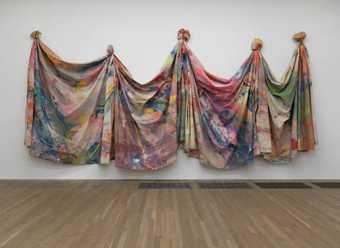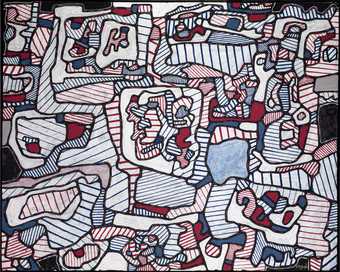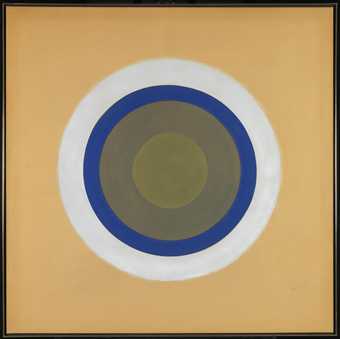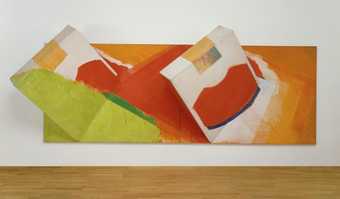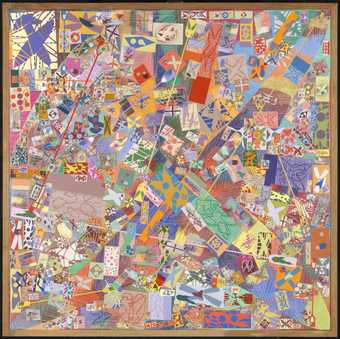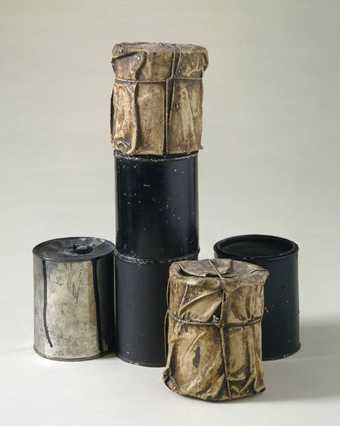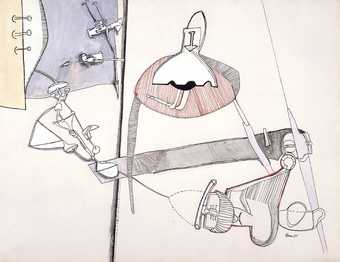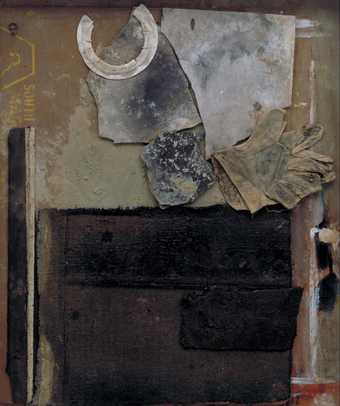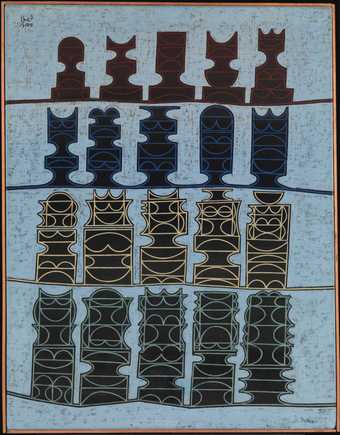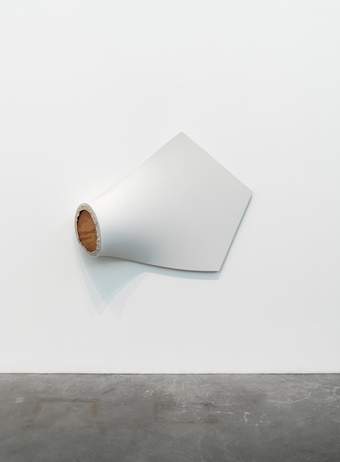
In Tate St Ives
- Artist
- Sam Gilliam 1933–2022
- Medium
- Acrylic on canvas and leather string
- Dimensions
- Object: 2159 × 1353 mm
- Collection
- Tate
- Acquisition
- Presented by Mrs Nesta Dorrance through the American Federation of Arts 1974
- Reference
- T01326
Summary
Simmering is a painting on a rectangular sheet of cotton duck canvas that hangs vertically from a single point on the wall from a tied leather string. The sheet of canvas is hung so that its lower edge is a short distance from the floor. Its left and right edges are spread out slightly on either side, and a section is folded over at the top, forming a semicircular shape, and is held in place using the leather string. These are the only constant elements of the work’s overall composition, since each time Simmering is hung it takes on a different form, with the folds and curves of the canvas changing with each re-installation. Simmering is dominated by diffuse pink and orange tones in acrylic paint that has soaked deeply into its fabric, and these colours bleed into areas of blue and turquoise at the bottom of the painting. Several sections also feature splashes and lines of vibrant yellow paint that have been applied in a seemingly chaotic manner and are dried onto the canvas’s surface rather than being soaked in, giving them a greater vibrancy than the other tones.
This work was made by the American painter Sam Gilliam in Washington, DC, in 1970. He created it by spreading the canvas out on the floor and covering it with acrylic paint in layers of varying thickness. Gilliam used substantial amounts of water to thin the paint, and applied it wet-on-wet so that the colours mixed together within the fibres of the canvas, leading to their diffuse appearance. After the paint had dried, Gilliam suspended the canvas from a wall and applied the drips and splashes of paint using a less heavily diluted yellow acrylic.
Simmering is part of a series of paintings Gilliam made in 1970 called Cowls, a name that reflects the paintings’ resemblance to hanging cloaks. As with many of Gilliam’s works, the title Simmering does not have a clear relationship with the painting, although it is possible that he chose the word in order to reflect the spark-like quality of the dynamic yellow patches or the warmth of the work’s orange and pink tones.
This work is one of many canvases that Gilliam has painted since 1968 which, rather than being stretched over frames and turned into taut, flat surfaces, are left to hang loose and fold into flaps and curves. Gilliam has called these works ‘drape paintings’, and Simmering is one of the smaller works in this group, with several of the others covering long sections of walls or taking up large portions of a room (Gilliam in Forgey 1989, accessed 23 October 2014). In 1973 Gilliam claimed that one reason for working with unstretched canvas was that he wanted to ‘deal with the canvas as material … using it as a more tactile way of painting’ (Gilliam in Donald Miller, ‘Hanging Loose: An Interview with Sam Gilliam’, ARTnews, vol.72, no.1, January 1973, p.42). At the time that Simmering was made, many critics wrote that this new emphasis on the material characteristics of canvas sheets made Gilliam’s drape paintings highly innovative. For instance, in 1970 the art critics Walter Hopps and Nina Felshin Osnos claimed that ‘Gilliam stands as the first among current painters to eliminate the rigid supports and use directly the flexible, draping properties of canvas as an integral structural element of the painting itself’ (Hopps and Felshin Osnos 1970, p.32).
The artist stated in 1984 that works like Simmering were produced out of a desire to make art that would be ‘more process oriented’ and ‘fluid’ than most paintings (Kenneth Young, ‘Oral History Interview with Sam Gilliam’, 8 September 1984, Archives of American Art, Smithsonian Institution, http://www.aaa.si.edu/collections/interviews/oral-history-interview-sam-gilliam-11449, accessed 23 October 2014). Simmering produces a sense of fluidity through the way that many of its tones bleed into one another rather than being divided into neat areas. It also incorporates an ongoing process in that its appearance changes each time it is re-hung. The art critic Jonathan P. Binstock has argued that this lack of fixity and Gilliam’s refusal to create a ‘finished’ artwork is made visible in Simmering and in the other drape paintings through their ‘casual and even seemingly careless disposition ... [that produces a] seemingly haphazard effect’ (Corcoran Gallery of Art 2005, p.46). In the late 1960s and early 1970s this emphasis on ongoing processes rather than static objects was shared by many other artists working in America, such as Alan Saret, Robert Morris and Bill Bollinger, whose work is often known as ‘post-minimal’ or ‘process’ art since, like Gilliam, they made pieces that take on different compositions every time they are shown.
Further reading
Walter Hopps and Nina Felshin Osnos, ‘Three Washington Artists: Gilliam, Krebs and McGowin’, Art International, vol.13, no.5, May 1970, pp.32–42.
Sam Forgey, ‘Oral History Interview with Sam Gilliam’, 4–11 November 1989, Archives of American Art, Smithsonian Institution, http://www.aaa.si.edu/collections/interviews/oral-history-interview-sam-gilliam-11472, accessed 23 October 2014.
Sam Gilliam: A Retrospective, exhibition catalogue, Corcoran Gallery of Art, Washington, DC 2005.
David Hodge
October 2014
Supported by Christie’s.
Does this text contain inaccurate information or language that you feel we should improve or change? We would like to hear from you.
Display caption
Every time this ‘drape painting’ is hung it takes on a different form, with the folds and curves of the canvas changing with each re-installation. Gilliam spread the canvas out on the floor and covered it with diluted acrylic paint in layers so colours mixed together within the fibres of the canvas. He then suspended the canvas from a wall and applied drips and splashes of thicker paint. It was, he explained, an attempt to ‘deal with the canvas as material … using it as a more tactile way of painting.’
Gallery label, January 2016
Does this text contain inaccurate information or language that you feel we should improve or change? We would like to hear from you.
Catalogue entry
T01326 Simmering 1970
Inscribed '85 x 52" | Sam Gilliam' on back of canvas, at top
Suspended painting in acrylic on canvas, 85 x 53 1/4 (215.5 x 135.3) (full canvas size, apart from a 30 1/4 (76.8) more or less semi-circular section folded forward at the top)
Presented by Mrs Nesta Dorrance through the American Federation of Arts 1974
Prov: Mrs Nesta Dorrance, Washington (purchased from the artist)
This painted canvas is intended to hang against a wall, suspended from a single point, with the 'cape' spread out sideways and the bottom just above the floor.
The artist has written of it (letter of 19 August 1975): 'It is called Simmering, was painted in 1970, and has not been exhibited. It is part of a series called "Cowls", made in 1970 and exhibited in Washington, DC at the Jefferson Place Gallery. In subsequent years, works of this series have been called capes, or half circle forms.
'Starting in 1968, after a series of exploratory watercolors, I began to experiment with hanging large canvases to the wall of the studio by tacking them directly. Initially, because it was directly related to painting them flat on the floor. Later, it freed one of the work of making stretchers for them. Still later, under the influence of both shaped canvases in general, and the work of Morris Louis, I started hanging 75-foot lengths of canvas in my studio, upon which I stained paint. After much consideration, I decided to exhibit the works unstretched, realizing that the softness and malleability of the canvas was in context a way of combining not only painting and drawing simultaneously, but also influencing shape and composition.
'In 1969, I exhibited the first of large works both on and off the wall as part of an exhibition at the Corcoran Gallery of Art in Washington, DC. In 1970, I started making a series of single panel, small, one and two pointed works, of which your painting is an example. The works were begun on the floor by pouring and layering various densities of thinned-out acrylic pigment onto cotton duck canvas.
'Finally, the work was completed by being allowed to dry and drain in the air. In instances, paint was then poured or applied while the painting was suspended.'
Published in:
Ronald Alley, Catalogue of the Tate Gallery's Collection of Modern Art other than Works by British Artists, Tate Gallery and Sotheby Parke-Bernet, London 1981, pp.286-7, reproduced p.286
Explore
- abstraction(8,615)
-
- from recognisable sources(3,634)
-
- man-made(999)
- non-representational(6,161)
-
- irregular forms(2,007)
- clothing and personal items(5,879)
-
- cloak(192)
You might like
-
Sam Gilliam Carousel Change
1970 -
Jean Dubuffet Site Inhabited by Objects
1965 -
Kenneth Noland Gift
1961–2 -
John Chamberlain Kora
1963 -
Stephen Buckley Nice
1972 -
Richard Smith Gift Wrap
1963 -
Bernard Cohen Matter of Identity III - The Trace
1977–9 -
Christo (Christo Javacheff) Wrapped Cans. Part of Inventory
1959–60 -
Eva Hesse Untitled
1965 -
William Scott Permutations Ochre
1978 -
Harry Thubron Caracol
1981 -
Sir Terry Frost May 1962 (Stays)
1962 -
Anwar Jalal Shemza Chessmen One
1961 -
Noriyuki Haraguchi Airpipe C
1969 -
Lynda Benglis GAMMA
1972

